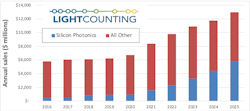Silicon photonics ready for lift off: LightCounting
Silicon photonics is about to become the optical integration force its backers have long predicted, according to LightCounting. The market research firm predicts in its most recent Integrated Optical Devices Report that nearly half of the optical transceivers, active optical cables (AOCs), and embedded optical modules (EOMs) produced in 2025 will contain some sort of silicon photonics component.
Silicon photonics long has been touted as a promising pathway to integrated photonics. It leverages CMOS-based semiconductor processes, thus promising to piggyback on semiconductor production volumes as a means of cost reduction. While no one has yet discovered a way to create light within silicon, silicon photonics still offers a better alternative than InP and GaAs as an integration platform, proponents assert.
The truth of those assertions will be borne out in the market over the next five years, LightCounting believes. As the chart above illustrates, the company’s analysts expect silicon photonics enabled optical transceivers, AOCs and EOMs will see their share of the total market increase from 14% in 2018-2019 to 45% by 2025. Greater confidence in silicon photonics as well as growth in applications that play to the approach’s strengths, such as co-packaged semiconductors and optics, will drive much of this share expansion. Nearer term, LightCounting expects 400ZR/ZR+ optical transceivers to be a winning application for silicon photonics (see, for example, the video “400G Module Update with Acacia Communications”).
LightCounting’s Integrated Optical Devices Report analyzes the impact of various integration strategies on the market for optical transceivers and related components in 2010-2019. It presents a forecast for shipments and sales of discrete and integrated products based on InP, GaAs, and silicon photonics technologies for 2020–2025. The forecast is segmented by main applications, including Ethernet, WDM, AOCs, and EOMs, and a few others. The report also covers the supply chain for silicon photonics products and profiles many of the startup companies developing integrated optical devices. A forecast for the adoption of co-packaged optics in 2023-2028 is also included.
For related articles, visit the Business Topic Center.
For more information on optical transceivers and suppliers, visit the Lightwave Buyer’s Guide.
To stay abreast of optical communications technology, subscribe to Lightwave’s Enabling Technologies Newsletter.

Stephen Hardy | Editorial Director and Associate Publisher, Lightwave
Stephen Hardy is editorial director and associate publisher of Lightwave and Broadband Technology Report, part of the Lighting & Technology Group at Endeavor Business Media. Stephen is responsible for establishing and executing editorial strategy across the both brands’ websites, email newsletters, events, and other information products. He has covered the fiber-optics space for more than 20 years, and communications and technology for more than 35 years. During his tenure, Lightwave has received awards from Folio: and the American Society of Business Press Editors (ASBPE) for editorial excellence. Prior to joining Lightwave in 1997, Stephen worked for Telecommunications magazine and the Journal of Electronic Defense.
Stephen has moderated panels at numerous events, including the Optica Executive Forum, ECOC, and SCTE Cable-Tec Expo. He also is program director for the Lightwave Innovation Reviews and the Diamond Technology Reviews.
He has written numerous articles in all aspects of optical communications and fiber-optic networks, including fiber to the home (FTTH), PON, optical components, DWDM, fiber cables, packet optical transport, optical transceivers, lasers, fiber optic testing, and more.
You can connect with Stephen on LinkedIn as well as Twitter.
